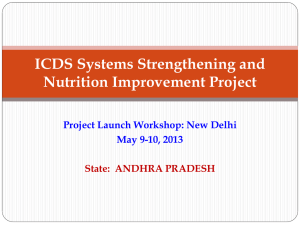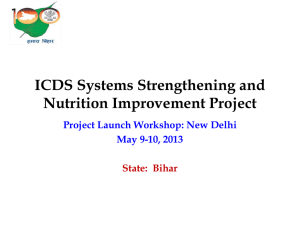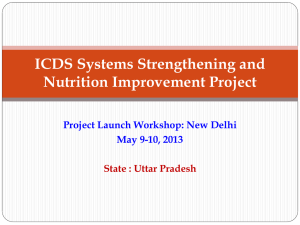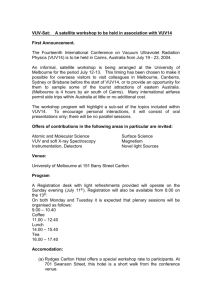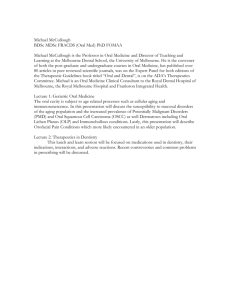slides - Stephan Sigg
advertisement
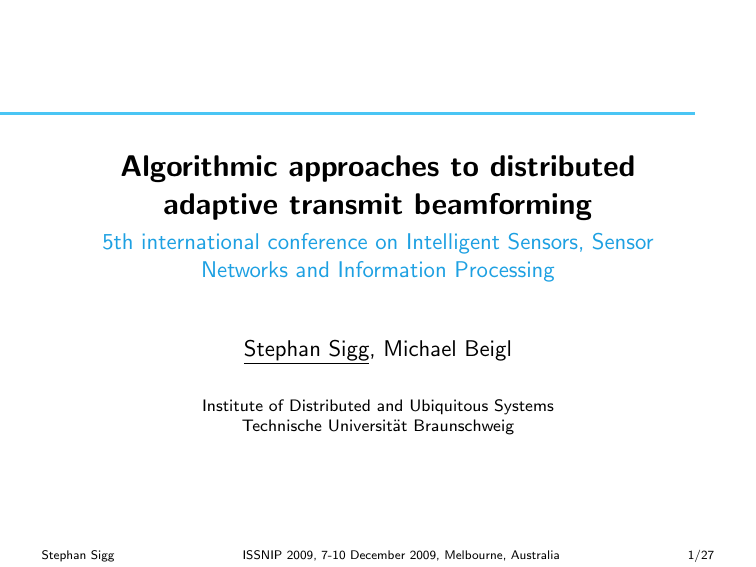
Algorithmic approaches to distributed adaptive transmit beamforming 5th international conference on Intelligent Sensors, Sensor Networks and Information Processing Stephan Sigg, Michael Beigl Institute of Distributed and Ubiquitous Systems Technische Universität Braunschweig Stephan Sigg ISSNIP 2009, 7-10 December 2009, Melbourne, Australia 1/27 Motivation The scenario of distributed adaptive transmit beamforming 1 1 R. Mudumbai, R.D. Brown, U. Madhow, and H.V. Poor: Distributed Transmit Beamforming: Challenges and Recent progress, IEEE Communications Magazine, 102-110, February 2009 Stephan Sigg ISSNIP 2009, 7-10 December 2009, Melbourne, Australia 2/27 Motivation The scenario of distributed adaptive transmit beamforming 2 2 R. Mudumbai, R.D. Brown, U. Madhow, and H.V. Poor: Distributed Transmit Beamforming: Challenges and Recent progress, IEEE Communications Magazine, 102-110, February 2009 Stephan Sigg ISSNIP 2009, 7-10 December 2009, Melbourne, Australia 3/27 Motivation The scenario of distributed adaptive transmit beamforming 3 3 R. Mudumbai, R.D. Brown, U. Madhow, and H.V. Poor: Distributed Transmit Beamforming: Challenges and Recent progress, IEEE Communications Magazine, 102-110, February 2009 Stephan Sigg ISSNIP 2009, 7-10 December 2009, Melbourne, Australia 4/27 Motivation The scenario of distributed adaptive transmit beamforming 4 4 R. Mudumbai, R.D. Brown, U. Madhow, and H.V. Poor: Distributed Transmit Beamforming: Challenges and Recent progress, IEEE Communications Magazine, 102-110, February 2009 Stephan Sigg ISSNIP 2009, 7-10 December 2009, Melbourne, Australia 5/27 Motivation The scenario of distributed adaptive transmit beamforming 5 5 R. Mudumbai, R.D. Brown, U. Madhow, and H.V. Poor: Distributed Transmit Beamforming: Challenges and Recent progress, IEEE Communications Magazine, 102-110, February 2009 Stephan Sigg ISSNIP 2009, 7-10 December 2009, Melbourne, Australia 6/27 Outline Algorithmic approaches to distributed adaptive beamforming 1 Motivation 2 A local random search approach Scenario analysis Simulations 3 An asymptotically optimal algorithm Multivariable equations 4 Conclusion Stephan Sigg ISSNIP 2009, 7-10 December 2009, Melbourne, Australia 7/27 Scenario analysis and algorithmic improvement Local random search Global random search: Synchronisation performance might deteriorate when the optimum is near With small local search space: Majority of worse points excluded Stephan Sigg ISSNIP 2009, 7-10 December 2009, Melbourne, Australia 8/27 Local random search An upper bound on the synchronisation performance Assumptions : Mutation probability: n−1 Uniform phase alteration Initial distance to the optimum : ≥ n·log(k) (Chernoff) 2 Technical assumption : Fitness space divided in k slices of identical width Stephan Sigg ISSNIP 2009, 7-10 December 2009, Melbourne, Australia 9/27 Local random search An upper bound on the synchronisation performance Analysis in two phases for the synchronisation process Phase 1: Optimum outside search neighbourhood for at least one node Phase 2: Optimum within search neighbourhood for all nodes Stephan Sigg ISSNIP 2009, 7-10 December 2009, Melbourne, Australia 10/27 Local random search An upper bound on the synchronisation performance Phase 1: Optimum is outside the neighbourhood Reach search point with improved fitness: ≥ Stephan Sigg ISSNIP 2009, 7-10 December 2009, Melbourne, Australia 1 2 11/27 Local random search An upper bound on the synchronisation performance When i signals synchronised: Improve n − i non-optimal signals i already optimal ones unchanged: 1 2 1 i n <e < 1− 1 n−1 n 1 n (n − i) · = since 1 − n−i 2n 1 n n · 1− i · 1 − n1 si ≥ · n−i 2en Expected number of mutations to increase fitness bounded by si−1 . Stephan Sigg ISSNIP 2009, 7-10 December 2009, Melbourne, Australia 12/27 Local random search An upper bound on the synchronisation performance Time until optimum is within the neighbourhood? Constant time to leave slice k distinct slices E [TP ] ≤ c· Pk 2en i=0 n−i = 2cen · k+1 X i −1 i=1 < 2cen · ln(k + 1) = O (n · log(k)) Stephan Sigg ISSNIP 2009, 7-10 December 2009, Melbourne, Australia 13/27 Local random search An upper bound on the synchronisation performance Phase 2: Optimum within search neighbourhood Worst case: Increase fitness with probability Similar to consideration above: 1 N O(N · n · log(k)) Overall synchronisation time: Weak estimation N = O(k) leads to O(k · n · log(k)). Stephan Sigg ISSNIP 2009, 7-10 December 2009, Melbourne, Australia 14/27 Mathematical simulation environment Impact of the node choice Fitness measure: v u τ Pn uX ( i=1 si + snoise (i) − s ∗ )2 RMSE = t . n t=0 Stephan Sigg ISSNIP 2009, 7-10 December 2009, Melbourne, Australia 15/27 Scenario analysis and algorithmic improvement Local random search Stephan Sigg ISSNIP 2009, 7-10 December 2009, Melbourne, Australia 16/27 Outline Algorithmic approaches to distributed adaptive beamforming 1 Motivation 2 A local random search approach Scenario analysis Simulations 3 An asymptotically optimal algorithm Multivariable equations 4 Conclusion Stephan Sigg ISSNIP 2009, 7-10 December 2009, Melbourne, Australia 17/27 Multivariable equations Received sum signal Reduce the amount of randomness in the optimisation Improve the synchronisation performance Improve the synchronisation quality Stephan Sigg ISSNIP 2009, 7-10 December 2009, Melbourne, Australia 18/27 Multivariable equations Received sum signal Fitness function observed by single node Constant carrier phase offset for n − 1 nodes Fitness function: F(Φi ) = A sin(Φi + φ) + c Stephan Sigg ISSNIP 2009, 7-10 December 2009, Melbourne, Australia 19/27 Multivariable equations Received sum signal Approach: Measure feedback at 3 points Solve multivariable equations Apply optimum phase offset calculated F(Φi ) = A sin(Φi + φ) + c Stephan Sigg ISSNIP 2009, 7-10 December 2009, Melbourne, Australia 20/27 Multivariable equations Received sum signal Problem: Calculation not accurate when two or more nodes alter the phase of their transmit signals Stephan Sigg ISSNIP 2009, 7-10 December 2009, Melbourne, Australia 21/27 Multivariable equations Solution Node estimates the quality of the function estimation itself Transmit with optimum phase offset and measure channel again When Expected fitness deviates significantly from measured fitness, discard altered phase offset Deviation: 1 node: ≈ 0.6% 2 nodes: ≈ 1.5% 3 nodes: > 3% Stephan Sigg ISSNIP 2009, 7-10 December 2009, Melbourne, Australia 22/27 Multivariable equations Synchronisation process 1 Transmit with phase offsets γ1 6= γ2 6= γ3 ; measure feedback 2 Estimate feedback function and calculate γi∗ 3 Transmit with γ4 = γi∗ 4 If deviation smaller 1% finished, otherwise discard γi∗ Stephan Sigg ISSNIP 2009, 7-10 December 2009, Melbourne, Australia 23/27 Multivariable equations Received sum signal Asymptotic synchronisation time: O(n) Classic approach:6 Θ(n · k · log(n)) 6 Sigg, El Masri and Beigl, A sharp asymptotic bound for feedback based closed-loop distributed adaptive beamforming in wireless sensor networks (submitted to Transactions on Mobile Computing) Stephan Sigg ISSNIP 2009, 7-10 December 2009, Melbourne, Australia 24/27 Multivariable equations Performance estimation Stephan Sigg ISSNIP 2009, 7-10 December 2009, Melbourne, Australia 25/27 Conclusion Algorithms for distributed adaptive beamforming in WSNs Performance improvements possible by local random search Upper bound on the synchronisation time: O(k · n · log(k)) Asymptotically optimal optimisation approach Synchronisation time O(n) Synchronisation quality improved Stephan Sigg ISSNIP 2009, 7-10 December 2009, Melbourne, Australia 26/27 Questions? Thank You for your attention. sigg@ibr.cs.tu-bs.de Stephan Sigg ISSNIP 2009, 7-10 December 2009, Melbourne, Australia 27/27
